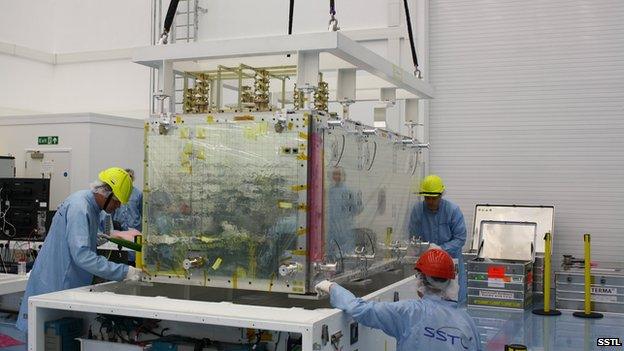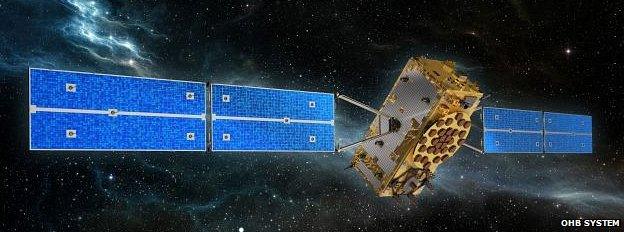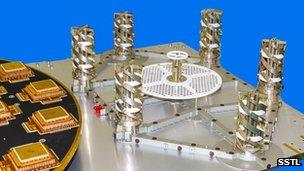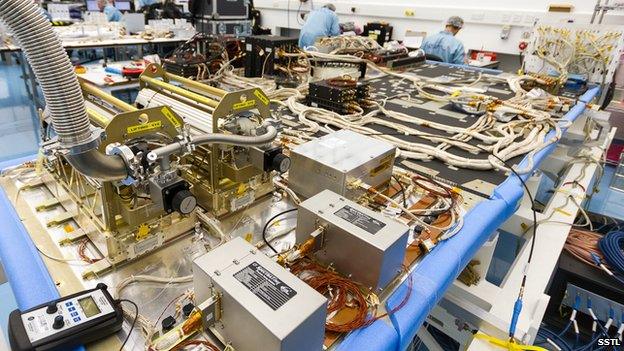Galileo payload milestone reached
- Published

The first payload is lowered into its shipping box at SSTL in Guildford
Another important milestone has been reached in the development of Europe's Galileo satellite-navigation system.
The British manufacturer <link> <caption>SSTL</caption> <url href="http://www.sstl.co.uk/" platform="highweb"/> </link> has completed the first of 22 spacecraft payloads for the orbiting network.
The payload is really the "brains" of the satellite and incorporates the atomic clocks that lie at the heart of space-borne timing and positioning.
SSTL has shipped the unit to its partner on the Galileo project - <link> <caption>OHB System</caption> <url href="https://www.ohb-system.de/" platform="highweb"/> </link> - for final preparation.
The Bremen-based outfit received it on Thursday morning and will now start to attach all the other parts required for a flight-ready satellite.
"In Bremen, they will bring the two halves of the satellite together - our payload and their platform," explained Clare Martin, the held of telecoms and navigation at SSTL.
"The platform includes the power, the computer, the attitude control - it's the spacecraft bus. The OHB platform is attached to three panels, and they are slotted together with the three panels that incorporate our payload."
The finished spacecraft is expected to launch on a Soyuz rocket from the Sinnamary spaceport in French Guiana sometime next year.

An artist's impression of the OHB-SSTL satellite in orbit
When it gets into orbit it should find four other Galileo satellites already in place. These are the pathfinder models being sent up ahead of the main operational batch to validate the design of Galileo and to demonstrate that it works, end to end - from ground to space to users.
Galileo is a flagship space project of the European Commission, the EU's executive arm.
The EC is investing billions in its "rival" to the American Global Positioning System (GPS), believing it will bring significant returns to member-state economies in the form of new businesses that can exploit precise timing and location data delivered from orbit.
Galileo's next-generation technologies are designed to provide users with quicker, more reliable fixes, enabling them to locate their positions with an error of one metre, compared with the current GPS error of several metres.
GPS already underpins a great swathe of activity with many uses that are unseen and unsung, such as the timing signal's widespread role in synchronising telecommunications systems and major financial transactions.
The first pair of pathfinder satellites was launched in October last year. The remaining pair of validators is scheduled to launch later this year.
These four satellites were made by a different manufacturing consortium led by Europe's two biggest space companies, Astrium and Thales Alenia Space.
But for the larger part of the operational constellation, the European Commission has engaged two of Europe's up and coming space companies.
OHB System formally leads the partnership with SSTL, based in Guildford.
The team has been awarded two batch contracts. The first, issued in January 2010, and valued at 566m euros (£510m), called for the production of 14 operational spacecraft. The second contract, valued at 255m euros (£210m), was signed in February. It covers the manufacture of an additional eight satellites.
The desire is to have all 26 Galileo satellites (four pathfinders; 22 OHB-SSTL spacecraft) in orbit by the end of 2015. A full and complete system of 30 satellites will require an ongoing commitment from the EC to purchase more satellites.
"Ultimately, the payloads will be coming out of Guildford at a rate of one every six weeks," said Clare Martin.
"The first one is slightly different in that it is subject to a series of stringent tests - simply because it is the first - that will take slightly longer. So, the plan is that the second payload will leave us later this summer, and then we will enter the production phase with the six-week cadence."

The S&R antennas are produced by the Rymsa company in Spain
The OHB-SSTL satellites are broadly similar to the pathfinders, and incorporate many of the same components, such as their hydrogen maser and rubidium atomic clocks.
One key difference is their search and rescue capability.
Galileo will provide a service that not only picks the location of a distress beacon - a sailor overboard, say - but will also radio back to the sender to confirm that the message has been received and that help is on its way.
In the pathfinders, the S&R payloads were to be provided from China, and were even installed. But these boxes were then removed when the EC's relationship with China over the Galileo programme over the project broke down.
The OHB-SSTL satellites are now being fitted with S&R antennas from the <link> <caption>Rymsa</caption> <url href="http://www.rymsa.com/" platform="highweb"/> </link> company in Spain, and transponder electronics from <link> <caption>Norspace</caption> <url href="http://www.kongsberg.com/en/kds/kns/" platform="highweb"/> </link> in Norway.

The two silver boxes at centre-bottom are rubidium atomic clocks; the two silver tubes at centre-left are the more precise hydrogen maser units
Jonathan.Amos-INTERNET@bbc.co.uk and follow me on <link> <caption>Twitter</caption> <url href="https://twitter.com/#!/BBCAmos" platform="highweb"/> </link>
- Published2 February 2012
- Published21 October 2011
- Published8 March 2012
- Published27 January 2012
- Published22 June 2011
- Published26 October 2010